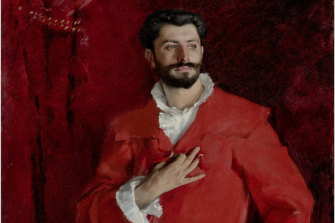History
The Man in the Red Coat
Julian Barnes
Jonathan Cape, $39.99
Julian Barnes is the author of Flaubert’s Parrot, which happens to be a masterpiece and is also a kind of homage to the author of Madame Bovary. Barnes is sometimes referred to as the best French writer in English and the French are so receptive to his work that they have given him the Legion d’honneur.
Dr Pozzi at Home. Painted in 1881 by John Singer Sargent.Credit:Metropolitan Museum of Art
Now he has written a strange, densely literary account of the Belle Epoque, that glorious, hectic dangerous last stretch of the Parisian 19th century that is the backdrop to Proust and a thousand lesser re-animators of a world of swagger and style and salons full of malice and diamonds and indolent elegance. It’s funny because The Man in the Red Coat, printed on beautiful cream paper with very fine illustrations, is almost a coffee table book.
It is also a weird book, not least because the cover crops the John Singer Sargent painting that gives it its title, thus eliminating the head of the subject, Samuel Pozzi, the great French surgeon. It makes sense, of course, because Sargent, the greatest portraitist of his day, the man you see on those covers of Henry James and Edith Wharton novels, said to Pozzi: ‘‘It’s not about you, it’s about the coat.’’
And the coat, the dressing gown or whatever it is, is a thing of wonder that will repay the attention of anyone who goes to contemplate its rich scarlet vibrancy hanging in Los Angeles’ Hammer Museum.
We begin, a bit strangely but not altogether surprisingly, with Henry James’ account from 1885 of the three Frenchmen he had met through Sargent when they went to London – as Frenchmen did back then – for the tailoring.
Julian Barnes.Credit:Urszula Soltys
One was Pozzi, whose coat outshines his quiet countenance but not his delicate hands. The second is Prince Edmond de Polignac – Catholic, gay, bemused by the vicissitudes of life – and the third is a face that leaps out because it is the face of Count Robert de Montesquiou-Fezensac, the man whose image was on the cover of the Penguin classic translation of Huysmans' Against Nature and who Alain Delon impersonated in Volker Schlondorff’s film of Swann’s Way because he is thought to have been the model for the Baron de Charlus, that tragicomic monster who stalks A la recherche du temps perdu.
Barnes says they’re all a bit like figures from Proust but they’re not quite. We get Whistler’s portrait of de Montesquiou-Fezensac (blackened by the day because of the bitumen that went into its composition) as well as the signature Giovanni Boldini portrait. But the burden of this strange book about the French, at the very edge of some Brexit unknowable – which Barnes deplores with a rage formidable for its restraint – is very much a case of ‘‘Vive la France’’.
In one way, The Man in the Red Coat is like an endless set of silken handkerchiefs of anecdote pulled from a magician’s hat that testifies to the pure exoticism and savagery of a civilisation intimately proximate to our own but with what dazzling, even blinding, differences of style.
One part of Barnes seems to want to cry ‘‘perfidious Albion’’ as Charles de Gaulle always did so that his long-ago refusal to allow Britain into what was then the Common Market takes on a retrospective validity. Then again, Barnes muses that had ancient injuries not meant so much to the pig-headed general, the British Lion might have learned to lie down with the French Lamb long ago.
Credit:
Pozzi, of Italian background and Protestant upbringing, is at the centre of this haunted elegy to the glory of France. He was a revolutionary surgeon, a great gynaecologist and a man who was the lover of everyone from Sarah Bernhardt down.
The Man in the Red Coat constantly seems to distract from its chief subject as more and more stories of mad duels and fantastically flamboyant abuse crowd the narrative and every kind of flaneur and dandy, every kind of besotted anti-Dreyfusard anti-Semite elbows their way into the narrative.
You shake your head at how often you’re told of more or less monstrous crimes passionnels, blatant murders that result in astonishing acquittals until you come to the end of its story, with its shocking biographical climax.
But The Man in the Red Coat has plenty of riveting narrative material. There is the figure of Pozzi’s daughter Catherine and her very individual bond with her eminent father as well as the eloquent figure of the Catholic wife Thérèse whom he betrayed over and over. She said of course she didn’t love him and then, just as credibly, of course she did.
This is a remarkable book. It is an anthology of the idiosyncratic voices of the late-19th century French. Everyone is here, from Colette to the eternally abusive Leon Daudet. In the end it is an extraordinary monument, which seems to come from a deep well of compassion and sadness, to the sheer strangeness and vivacity of human life and the wonder of mastering the language of a great nation so like and unlike ourselves.
Source: Read Full Article


